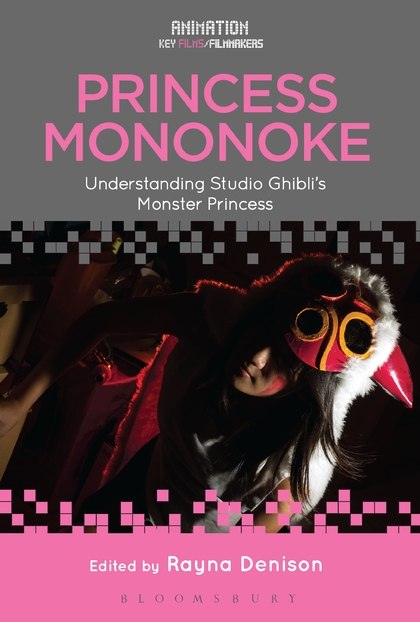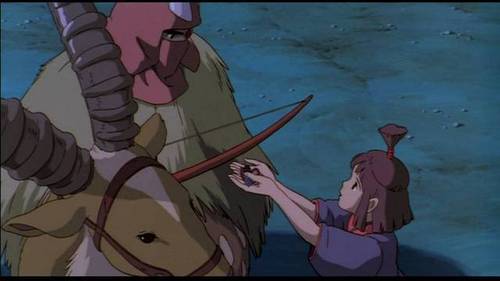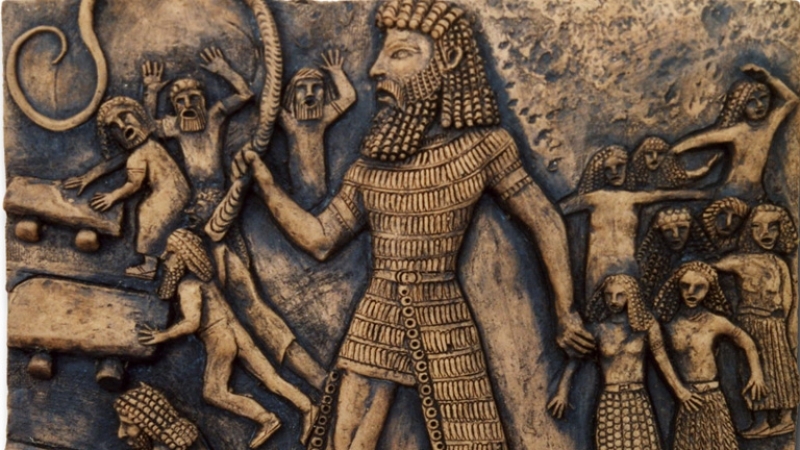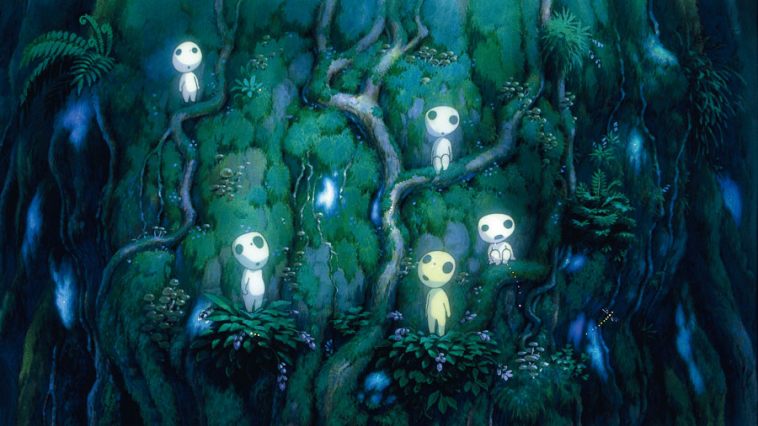Books: Princess Mononoke
August 30, 2019 · 0 comments
By Andrew Osmond.
 Princess Mononoke: Understanding Studio Ghibli’s Monster Princess functions as a 20th anniversary collection on one the most important anime of the late 20th century… but “important” to whom? Twenty years ago, Hayao Miyazaki’s film became an anime blockbuster, at least in Japan. In America and Britain, it had extremely limited cinema releases – indeed, its British cinema “release” was at a single venue, London’s Barbican Centre. Alas, Mononoke opened too soon to benefit from the Animated Oscar category, which debuted in 2001 and boosted Miyazaki’s Spirited Away the next year.
Princess Mononoke: Understanding Studio Ghibli’s Monster Princess functions as a 20th anniversary collection on one the most important anime of the late 20th century… but “important” to whom? Twenty years ago, Hayao Miyazaki’s film became an anime blockbuster, at least in Japan. In America and Britain, it had extremely limited cinema releases – indeed, its British cinema “release” was at a single venue, London’s Barbican Centre. Alas, Mononoke opened too soon to benefit from the Animated Oscar category, which debuted in 2001 and boosted Miyazaki’s Spirited Away the next year.
One of my first pieces of anime journalism was a Guardian piece bemoaning the lack of British commercial interest in Mononoke. Emma Pett, a lecturer at the University of East Anglia who has studied hundreds of articles and reviews for the Mononoke book, suggests an explanation: “A significant number of reviews published for the film in the late 1990s and early 2000s strongly emphasise that Princess Mononoke is ‘not a film for the kids’… Indeed, if there is one point that professional critics share a consensus on, it is that Mononoke is unsuitable for children.”
 How times have changed! As of 2018, Mononoke is well up in the top hundred “Kids & Family” DVD list on Amazon. And while Mononoke may never have been a cinema smash in America, it seems embedded in today’s Hollywood fantasy. Disney’s CG Moana, a truly global smash, has what looks like a massive homage to Mononoke (though the relevant clip spoils the end if you’ve not seen it). There are also likely homages in Hellboy 2: The Golden Army (here), by self-confessed anime geek Guillermo del Toro, and in Snow White and the Huntsman (here) by Rupert Sanders, who’d remake Ghost in the Shell.
How times have changed! As of 2018, Mononoke is well up in the top hundred “Kids & Family” DVD list on Amazon. And while Mononoke may never have been a cinema smash in America, it seems embedded in today’s Hollywood fantasy. Disney’s CG Moana, a truly global smash, has what looks like a massive homage to Mononoke (though the relevant clip spoils the end if you’ve not seen it). There are also likely homages in Hellboy 2: The Golden Army (here), by self-confessed anime geek Guillermo del Toro, and in Snow White and the Huntsman (here) by Rupert Sanders, who’d remake Ghost in the Shell.
The book is edited and introduced by Rayna Denison, author of Anime: A Critical Introduction. She stresses Mononoke’s ambitious genesis, noting that it was budgeted at around $30 million, huge for anime, and was the first Ghibli film to make extensive use of computer-aided effects. As such, it followed in Hollywood’s wake. Contemporary Disney cartoons like Beauty and the Beast and The Lion King had much-publicised moments of CG spectacle amid their traditional animation. But Toy Story was already on the scene (released 1995) and in a few years the “drawn” Hollywood cartoon film would be practically dead. In Japan, though, the “tradigital” legacy has endured; look at Ghibli fanboy Makoto Shinkai.
Within Denison’s generally admirable introduction, I’d object to her comment that Mononoke’s “division between simplified foreground characters and richly detailed backgrounds is a hallmark of ‘limited’ animation styles, perhaps especially anime.” Actually, it’s an approach one can find in Disney’s Sleeping Beauty, Ireland’s Song of the Sea and practically any CG film featuring humans (see Coco). It may be rooted in pre-CG restrictions – try animating a hyper-detailed character on paper without computer software – but it’s also an aesthetic that has been long championed by comics critic Scott McCloud (Understanding Comics).
Another apparent slip – Denison refers to the animator Yoshifumi Kondo, one of Mononoke’s supervising animators, as a staff member at the TopCraft studio, which made Nausicaa. The text suggests Ghibli “inherited” him afterward. I’m not aware that Kondo – who directed Ghibli’s lovely Whisper of the Heart – was ever a TopCraft staffer, but in any case he’d worked with Miyazaki at other studios since the early 1970s.
 Jennifer E. Nicholson’s paper on Mononoke’s translation mentions that Neil Gaiman, who was involved with the English dub of the film, was surprised to see Kaya, the girl who sees Ashitaka off, identified as his sister in the final dub. Gaiman said, “nobody seemed to know where that had come from,” but Nicholson points out Kaya calls Ashitaka ani (elder brother) in the Japanese version. This detail seems to have been omitted from the material that Gaiman – a non-Japanese speaker – was given. However, it’s worth noting that Miyazaki himself said the characters were not biological siblings, which may be why the confusion arose.
Jennifer E. Nicholson’s paper on Mononoke’s translation mentions that Neil Gaiman, who was involved with the English dub of the film, was surprised to see Kaya, the girl who sees Ashitaka off, identified as his sister in the final dub. Gaiman said, “nobody seemed to know where that had come from,” but Nicholson points out Kaya calls Ashitaka ani (elder brother) in the Japanese version. This detail seems to have been omitted from the material that Gaiman – a non-Japanese speaker – was given. However, it’s worth noting that Miyazaki himself said the characters were not biological siblings, which may be why the confusion arose.
Two papers in the book’s first section, by Shiro Yoshioka and Eija Niskanen, focus on the Mononoke’s Japaneseness. On a commercial level, Yoshioka argues that Mononoke was helped in Japan by the rise of new multiplexes, where “programming was not under the control of film distribution companies”, often run by Miyazaki fans. Yoshioka and Niskanen also highlight how the film grew out of Miyazaki’s evolving views of history, ecology and spirituality. These papers should be read alongside Starting Point and Turning Point, Miyazaki’s collected writings, which have reams to say on these subject (this blog discussed some of the spiritual subjects here, and gives the historic context here.)
Both bring up the vexed subject of nihonjinron, the theories of an “essence” of Japaneseness which might be implied by the film, though Miyazaki has denounced political nationalism often enough. Niskanen, though, highlights how Mononoke is an outsider story, where most of the protagonists belong to despised groups and suppressed ethnicities. It would be fascinating to know how Mononoke was received by Japanese Koreans, or by the descendants of burakumin.
 Yoshioka notes that one of Miyazaki’s acknowledged inspirations was a play by Japanese intellectual (and nihonjinron advocate) Takeshi Umehara, called Gilgamesh. Umehara sent Miyazaki the play for a possible anime adaption, but was turned down. After Mononoke, Umehara reminded him of this and Miyazaki admitted he “had included some of my impressions” of the play (the exchange is in Turning Point, pp. 96-7). But Yoshioka could have added that the original Gilgamesh legend – perhaps the world’s oldest surviving story, from ancient Mesopotamia – originated elements of Mononoke too (the hubristic quest to kill a forest god). Mononoke may be a Japanese fantasy, but not all Japanese.
Yoshioka notes that one of Miyazaki’s acknowledged inspirations was a play by Japanese intellectual (and nihonjinron advocate) Takeshi Umehara, called Gilgamesh. Umehara sent Miyazaki the play for a possible anime adaption, but was turned down. After Mononoke, Umehara reminded him of this and Miyazaki admitted he “had included some of my impressions” of the play (the exchange is in Turning Point, pp. 96-7). But Yoshioka could have added that the original Gilgamesh legend – perhaps the world’s oldest surviving story, from ancient Mesopotamia – originated elements of Mononoke too (the hubristic quest to kill a forest god). Mononoke may be a Japanese fantasy, but not all Japanese.
That case is also made by Julia Alekseyeva, who sees foreshadowings of Mononoke in a classic Russian cartoon, 1957’s Snow Queen, that’s one of Miyazaki’s favourites. I confess I found some of her arguments tenuous, though the idea that Mononoke’s feral, knife-wielding San is descended from a “robber girl” in Snow Queen is attractive, given Miyazaki’s comments on the character in Turning Point. But the paper is equally interesting for explaining how Snow Queen was celebrated by Japanese critics as a new kind of cartoon transcending Disney, much as Westerners would embrace Mononoke decades later.
Helen McCarthy goes well beyond Mononoke, with a broad reassessment of its director by an author who celebrated him two decades ago in her Hayao Miyazaki: Master of Japanese Animation. Since then, McCarthy says: “My own reading of the Miyazaki canon has changed… from wide-eyed amazement at the wonderfully real and effective female characters he created to a more reasoned, and possibly more jaded, awareness of the limitations placed on those characters by their creator.” However, she argues that Mononoke is the one time Miyazaki surpassed those limits, through San and Ashitaka, who “agree to live their own lives and make a private space belonging equally and entirely to them both.”
 Written in her usual vigorous prose, McCarthy’s article is hugely readable and engaging. For me, it was also – to pinch a phrase from her sometime co-author Jonathan Clements – “an edifice to argue with”, sometimes line by line. I disagree with many of McCarthy’s arguments, which I feel often presuppose their conclusions and distort the films. To focus on Mononoke-specific arguments, McCarthy head-scratchingly links Ashitaka to “hero kings, whose ultimate purpose is to sacrifice themselves for the life of the tribe” (a motif taken to twisted extremes in the Miyazaki-esque Eureka 7). But surely the whole point of Ashitaka is that he goes beyond tribalism all through the story?
Written in her usual vigorous prose, McCarthy’s article is hugely readable and engaging. For me, it was also – to pinch a phrase from her sometime co-author Jonathan Clements – “an edifice to argue with”, sometimes line by line. I disagree with many of McCarthy’s arguments, which I feel often presuppose their conclusions and distort the films. To focus on Mononoke-specific arguments, McCarthy head-scratchingly links Ashitaka to “hero kings, whose ultimate purpose is to sacrifice themselves for the life of the tribe” (a motif taken to twisted extremes in the Miyazaki-esque Eureka 7). But surely the whole point of Ashitaka is that he goes beyond tribalism all through the story?
I’d also challenge McCarthy’s claim that Miyazaki somehow “forged” Ashitaka through a line of preceding heroines, from Nausicaa to Kiki, when he’s so much a throwback to pre-Ghibli heroes. These include Shuna in Miyazaki’s 1983 picture-story Journey of Shuna (which was adapted for radio, with Shuna voiced in Japanese by future Ashitaka actor Yoji Matsuda). Indeed, Ashitaka traces back to Hols in 1968’s The Little Norse Prince, where Miyazaki worked with director Isao Takahata; the film shares many story and character points with Mononoke. As for McCarthy’s lauding of San for living a “self-determined life” (which actually seems mostly determined by her goddess mother), I found it filled out less compellingly than the picture of the happy artist Ursula in Kiki, living alone in a forest, drawing crows.
But, like McCarthy, I’m very interested in how Mononoke fits among Miyazaki’s other work. Yoshioka’s chapter points up how Mononoke seemed like a new, more serious kind of Miyazaki film, from a new, more serious Miyazaki; this was a shock from the genial director of Kiki and Porco Rosso. Yoshioka claims that Miyazaki “never returned to his earlier entertaining adventure stories,” which seems hard on the Oscar-winning Spirited Away. Mononoke makes an interesting contrast with Shinkai’s Your Name, another blockbuster breakout by a director with a respected track record. But Your Name, for all its serious elements, felt more comedic and populist than Shinkai’s past films (The Garden of Worlds, 5 Centimetres per Second).
 Mononoke brings Miyazaki’s films in line with the artist’s harsher manga, like his epic Nausicaa strip and his early Desert Tribe. I’ve also wondered if Mononoke – with its outsider’s view of an ambiguous conflict – might have been influenced by Miyazaki’s colleague-rival Mamoru Oshii, despite Miyazaki’s jocular rudeness about Oshii’s Patlabor 2 (which Oshii would avenge). The conflict in Mononoke is even more ambiguous than some viewers may realise. The line that annoys me most in the dub version is at the start, where a narrator claims that prior to the story, “Man and beast lived in harmony”. Not only is there no such line in the Japanese version, but the twee eco-Eden that’s suggested is soon overturned by the monk Jiko Bou, no medieval SJW, who makes clear this “balanced” state of nature is full of disaster and death. Small wonder Eboshi wants to tear it down.
Mononoke brings Miyazaki’s films in line with the artist’s harsher manga, like his epic Nausicaa strip and his early Desert Tribe. I’ve also wondered if Mononoke – with its outsider’s view of an ambiguous conflict – might have been influenced by Miyazaki’s colleague-rival Mamoru Oshii, despite Miyazaki’s jocular rudeness about Oshii’s Patlabor 2 (which Oshii would avenge). The conflict in Mononoke is even more ambiguous than some viewers may realise. The line that annoys me most in the dub version is at the start, where a narrator claims that prior to the story, “Man and beast lived in harmony”. Not only is there no such line in the Japanese version, but the twee eco-Eden that’s suggested is soon overturned by the monk Jiko Bou, no medieval SJW, who makes clear this “balanced” state of nature is full of disaster and death. Small wonder Eboshi wants to tear it down.
Pett points out that the “serious” Mononoke wasn’t universally lauded. The Times, for instance, called it “total hogwash.” Pett might have also quoted Jim McLennan, who was unusual among British print reviewers at the time Mononoke opened; he already knew Miyazaki’s oeuvre inside-out. Writing in Manga Max magazine #14 as part of a salon of contending opinions on the film, McLennan deemed Mononoke “Miyazaki’s worst film ever, being overlong, startlingly self-indulgent, poorly written and lacking many of the qualities which made his previous work such an unadulterated delight.” Finding Eboshi more sympathetic than San, McLennan compared Mononoke to “a Bond film where Blofeld is nicer than 007” and even to the “ego-trips” of Kurosawa’s last films.
More temperately, we could say Mononoke was Miyazaki’s most divisive film at the time. Not only could it disappoint fans of his previous work, it was less of a universal crowd-pleaser than, say, Kiki, which was already on American video. But while Kiki was released by Buena Vista, Disney’s distribution arm, Mononoke was ruled out by its violent content. Instead, Disney gave Mononoke to its most independent subsidiary, Miramax, founded by Bob Weinstein and his now unmentionable brother.
Mononoke’s marketing by Miramax is the subject of an interesting piece by Laz Carter, though it’s marred by his insisting on using the word “Disneyfication,” which has irrelevant connotations. Miramax publicised Miyazaki as an “influential animator” (who presumably influenced Western film-makers, thereby making him seem less foreign), while the Miramax logo reframed Mononoke as “domestic, albeit independent entertainment.” The English-dub voices hit multiple audience bases, from X-Files’ Gillian Anderson to the rising black actress Jada Pinkett Smith. The US marketing played down San in favour in Ashitaka, a familiar trick in American and Americanised cartoons.
Ironically, on the last pages Pett suggests that it’s San’s presence as a kick-ass feminist that helped maintain Mononoke’s presence abroad over the last nineteen years. It could be interesting to go deeper into this in another paper, considering San among later icons such as Katniss, Frozen’s Elsa and Mikasa Ackerman. I’d also like to see a paper on Princess Mononoke as a revisionist Western a la Unforgiven, set against the history of interchange between cowboys and samurai. Or perhaps there could be a paper on Mononoke, Wind Rises and self-insertion, given how Jiro, the hero of Wind Rises, is a colourless Miyazaki stand-in who suddenly goes all Ashitaka when an earthquake hits.
But the paper I’d really like to see would assess Mononoke’s gender-fluid content from a present-day perspective; from Akihiro Miwa’s extraordinary performance as a goddess, to San’s vehement identification as a wolf, to the inevitable “That’s a man?” reaction to Mononoke’s end song. And surely Ashitaka is a transgendered Nausicaa?
Andrew Osmond is the author of 100 Animated Feature Films. Princess Mononoke: Understanding Studio Ghibli’s Monster Princess is now available in paperback.
Leave a Reply